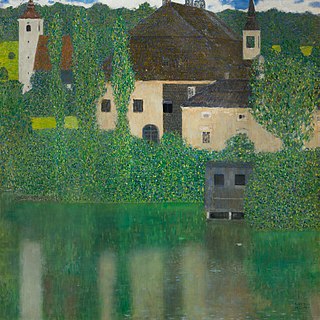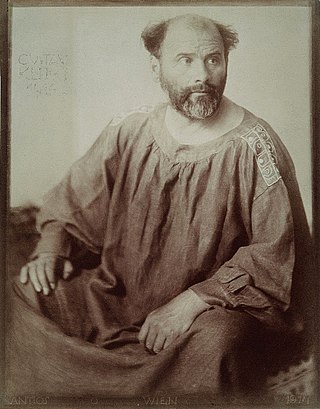
Gustav Klimt was an Austrian symbolist painter and one of the most prominent members of the Vienna Secession movement. Klimt is noted for his paintings, murals, sketches, and other objets d'art. Klimt's primary subject was the female body, and his works are marked by a frank eroticism. Amongst his figurative works, which include allegories and portraits, he painted landscapes. Among the artists of the Vienna Secession, Klimt was the most influenced by Japanese art and its methods.

Max Klinger was a German artist who produced significant work in painting, sculpture, prints and graphics, as well as writing a treatise articulating his ideas on art and the role of graphic arts and printmaking in relation to painting. He is associated with symbolism, the Vienna Secession, and Jugendstil the German manifestation of Art Nouveau. He is best known today for his many prints, particularly a series entitled Paraphrase on the Finding of a Glove and his monumental sculptural installation in homage to Beethoven at the Vienna Secession in 1902.

Attersee, also known as Kammersee, English sometimes Lake Atter, is the largest lake of the Salzkammergut region in the Austrian state of Upper Austria. It is Austria's third largest lake by area, surpassed only by Lake Constance and Lake Neusiedl, which, however, both of those larger lakes extend beyond national borders.
Republic of Austria v. Altmann, 541 U.S. 677 (2004), was a case in which the Supreme Court of the United States held that the Foreign Sovereign Immunities Act, or FSIA, applies retroactively to acts prior to its enactment in 1976.

The Österreichische Galerie Belvedere is a museum housed in the Belvedere palace, in Vienna, Austria.
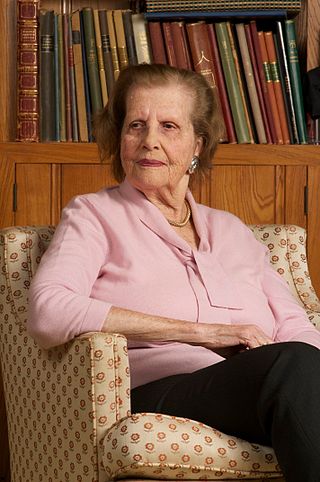
Maria Altmann was an Austrian-American Jewish refugee from Austria, who fled her home country after it was annexed to the Third Reich. She is noted for her ultimately successful legal campaign to reclaim from the Government of Austria five family-owned paintings by the artist Gustav Klimt that were stolen by the Nazis during World War II.

The Kiss is an oil-on-canvas painting with added gold leaf, silver and platinum by the Austrian Symbolist painter Gustav Klimt. It was painted at some point in 1907 and 1908, during the height of what scholars call his "Golden Period". It was exhibited in 1908 under the title Liebespaar as stated in the catalogue of the exhibition. The painting depicts a couple embracing each other, their bodies entwined in elaborate beautiful robes decorated in a style influenced by the contemporary Art Nouveau style and the organic forms of the earlier Arts and Crafts movement.

Portrait of Adele Bloch-Bauer I is an oil painting on canvas, with gold leaf, by Gustav Klimt, completed between 1903 and 1907. The portrait was commissioned by the sitter's husband, Ferdinand Bloch-Bauer, a Viennese and Jewish banker and sugar producer. The painting was stolen by the Nazis in 1941 and displayed at the Österreichische Galerie Belvedere. The portrait is the final and most fully representative work of Klimt's golden phase. It was the first of two depictions of Adele by Klimt—the second was completed in 1912; these were two of several works by the artist that the family owned.

Steinbach am Attersee is a municipality of the Vöcklabruck district in the Austrian state of Upper Austria. It is situated in the Hausruckviertel region on the eastern banks of the Attersee, part of the Salzkammergut area.

Josef Danhauser was an Austrian painter and one of the prominent artists of Biedermeier period, along with Ferdinand Georg Waldmüller, Peter Fendi, and others. Danhauser's works, which went largely unappreciated in his time, dealt with moralising subjects and had a clear influence of William Hogarth.
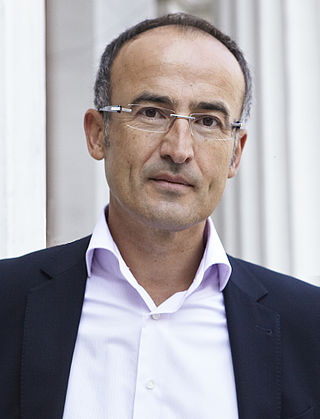
Tobias G. Natter is an Austrian art historian and internationally renowned art expert with a particular expertise in "Vienna 1900".

Emilie Louise Flöge was an Austrian fashion designer and businesswoman. She was the life companion of the painter Gustav Klimt.

Death and Life is an oil-on-canvas painting by Austrian painter Gustav Klimt. The painting was started in 1908 and completed in 1915. It depicts an allegorical subject in an Art Nouveau (Modern) style. The painting measures 178 by 198 centimeters and is now housed at the Leopold Museum in Vienna.
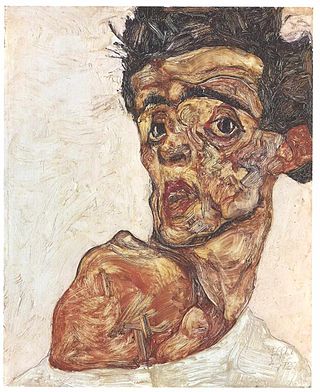
Facing the Modern: The Portrait in Vienna 1900 was an exhibition at the National Gallery, London, running from 9 October 2013 through to 12 January 2014.
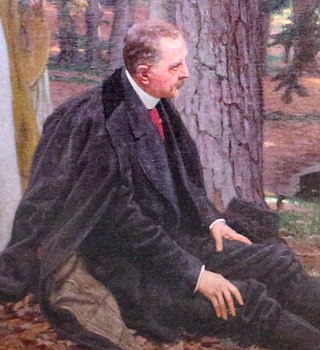
Friedrich König was an Austrian painter, illustrator and designer.

Leopold Forstner was an artist who was part of the Viennese Secession movement, working in the Jugendstil style, focusing particularly on the mosaic as a form.

Water Serpents II, also referred to as Wasserschlangen II, is an oil painting made by Gustav Klimt in 1907. It is the follow-up painting to the earlier painting Water Serpents I. Like the first painting, Water Serpents II deals with the sensuality of women's bodies and same-sex relationships. The painting has a rich history. During World War II, it was stolen by the Nazis, and more recently, it has been the center of a controversy surrounding its record 2013 sale. As of December 2019, it is the 6th most expensive painting in the world and the most expensive work by Klimt to sell.

Klimt Villa is a building located in the Hietzing district of Vienna built in the early 1920s upon the last Viennese studio of the painter Gustav Klimt.

Wilhelm Legler also Guglielmo Legler was a painter from Pisino, Istria.

Insel im Attersee is a 1901-1902 landscape painting by the Austrian artist Gustav Klimt (1862-1918).
